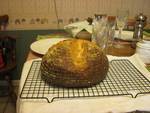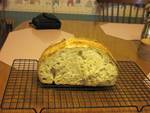This is a boule made this morning using all white flour and a third generation beer barm. By that I mean that after I concocted and used the original beer barm from Dan Leppard's recipe, I refreshed the leftover barm with flour and water to make another 100% starter, then refreshed the leftover from that to create the starter for this bread. The interior color seems to get paler with each refreshment of the starter, and the crumb more fluffy than dense, but I was happy with the result, especially the crust. For the very first time I got a crust that talked back. I really wouldn't call it singing, but maybe chirping?
And Eric (Hanner), it appears you were right. I took a deep breath, put my risen boule on a baking sheet and placed it in a cold oven with a bowl cover. I assigned the temperature to 500 degrees, baked for 30 minutes, then removed the bowl and baked at 475 for another 20 minutes. Oven off for another 5 minutes, et voici le résultat.


Te loaf looks beutiful and tasty!
Please, what kind of bowl cover did you use? And how high and large?
Thanks,
zdenka
Hi Zdenka,
Thank you, the bread was very tasty. I was pleased with both the crumb and the crust. Sorry the pictures aren't larger. It's hit or miss with me and these photo uploads!
I used a stainless steel mixing bowl, about 12 inches across and 10 inches high. It was relatively inexpensive -- less than $10. I use it exclusively for my breads and have been happy with the results.
Barbara
I am just trying to find something like this for "steaming". But I was not sure about the dimensions, so it would be enough for the loaf. And I am a little worried about using a pyrex bowl. The problem is I have not found any large roasting lid or la cloche here.
Stainless steel is a good idea - it should withstand 450°F...
zdenka
I am happy to see your bread was a success. You can change the image size if you edit the message and select, then drag the corner out slightly and save the change.
It is a little scary challenging the knowledge and accepted practices we hold dear. After all, we have the sum of our knowledge invested in every loaf we prepare for the oven. Once you discover that there are many ways to arrive at the same end, by adjusting the variables, you are liberated.
Eric
Scary is the right word. It isn't easy taking two days' work and rolling the dice on a different technique. Your recent posts have helped me to gather the courage to give this a try, and I'm happy I did. It's good to know I don't have to waste all that energy in heating up the oven. This way, I not only save time and resources, I get a better result.
I did try to extend the photos a little bit, but maybe too much. They now appear a little hazy. I'll keep working on that.
Barbara
One of the things that perplexes people when they first start baking with a natural levain is understanding the relationship between time and temperature as it effects culture activity. Not being able to accurately predict when your dough will be fermented and proofed just right, compels the baker to err on the side of being ready. Then the whole thing with pre heating this large thermal mass so we can emulate a hearth oven, well it's a daunting task to get everything to come together at the right time. How much easier to wait until the dough is ready to bake, then turn the oven on and bake it. Once you get your feet under you and feel more confident about the predictability of fermentation, by all means, heat up the stone if you think it helps.
My point in bringing this up is that my power utility bill is the largest expense I have to pay every month. When I'm only actually baking for 30 minutes, it kills me to waste the energy unnecessarily, especially when the improvement in crust is so limited.
Eric
Eric, please, do you wait until the loaf is fully proofed (as with baking in pre-heated oven) and then put it in the cold oven?
I have just tried the cold start - 450°C for 25min and 10min 400°C, with a cup of water the first 20min. The oven spring seems fine, and the crust crispier than yesterday (completely same recipe but pre-heated oven), but the slashing almost disappeared and I have impression there are a little heavier than yesterday. Also the browning took place earlier than with pre-heating.
I also wander whether it would be better to bake it with convection or just upper/down heating.
Do you have any suggestions?
zdenka
I have found that I can wait until the bread is almost ready to bake and then turn the oven on. You still get the benefit of not wasting energy for an hour if you turn it on 5 minutes before. This makes using water for steam inefficient since the water won't get hot enough for some time. For me, the best procedure is to get a 4 Liter Stainless Steel bowl or a bowl that will fit over a warp proof steel sheet pan. For me this is a double layer edgeless sheet pan for cookies. It doesn't warp out of shape during heating and the bowl makes a good fit and seal to hold the moisture in.
After 15 minutes or so, I use a spatula to lift the bowl enough to get my oven mitt under it and lift it out carefully. I usually have to slide the shelf out a little so I don't bump the bread. I keep telling myself I will one day install handles on the bowl so I don't have to use the spatula. Then it will become a single use object.
You can also spray the dough lightly with water just before you put it in the oven. This has a similar effect as steaming by softening the outside layer of skin so it can expand. You can spray-then slash, but it makes slashing harder.
I don't think convection would help much.
Hope this helps.
Eric
thank you very much!
I have just the baking sheets that were included with my Bosch oven (bought last year). You are certainly right that putting a cup water for cold start is not so efficient. That is what I observed this afternoon.
I will try to find a large stainless steel bowl. Or maybe better something that would fit oval loafs.
zdenka
Hi Zdenka,
I have heard of others using Pyrex bowls, with the added feature of being able to watch the bread as it rises. I would assume they are safe to use as people bake in Pyrex all the time. Using Eric's suggestion of prying the bowl up with a spatula before removing it seems like a good one. I'll have to try that one myself. I have also had trouble finding something large and long enough for my baguettes.
Barbara
Hi There Kolobezka,
I use a square pyrex with lid for my no knead bread. It works (I feel) just as well as a clay pot etc.........worth giving a go.
Cheers................Pete